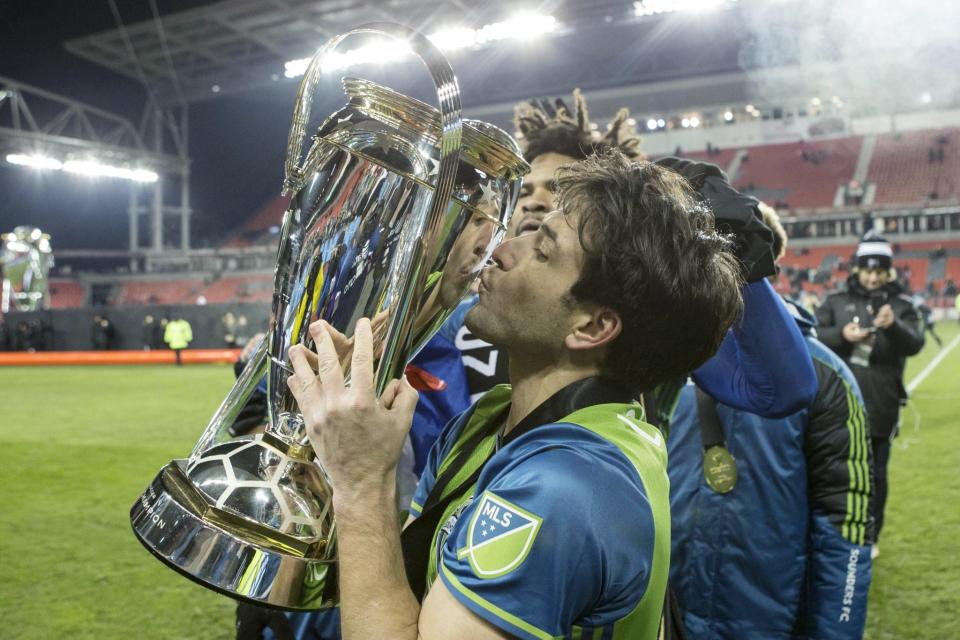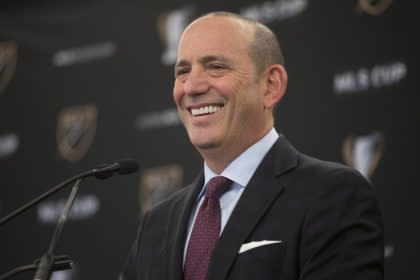MLS underscoring its own credibility by moving on from the Gerrards, Lampards and Drogbas

Major League Soccer will look very different in 2017. Because it will be joined by the respective Uniteds from Atlanta and Minnesota, to be sure. But mostly because it will likely sport less star power than it has in several years. That is to say, it will employ far fewer aging European household names, tempted stateside for a last hurrah, payday and curtain call.
This is a good thing.
And this is the legacy of the league’s 2016 season.
Because this past season, the Designated Player Rule came full circle. The sorts of players the rule was designed to attract – David Beckham and all the rest, whose magnetism and fame would bring new attention to a league going nowhere fast – now no longer represent the best use of the three dispensation players each team is allowed without counting towards their salary cap.
In 2016, Steven Gerrard quietly piled up 11 assists for the Los Angeles Galaxy but missed almost half the regular season with injuries and was never the most important player on his team. Frank Lampard scored 12 goals for New York City FC but was hardly the primary reason the club was so much improved. Robbie Keane no longer carried the Galaxy on his shoulders after being its linchpin for four years. Didier Drogba was actually benched by the Montreal Impact in favor of journeyman nobody Matteo Mancosu. Andrea Pirlo remained a very expensive piece of bling for NYCFC.
Next year, all but Pirlo will be gone, as their expiring contracts were not renewed. Had Pirlo’s deal been up, he may have suffered the same fate. Because in the grand scheme of this sort of signing, he’s now more a relic of a flashier and less practical time than a value-for-money asset.
The DPs that made the difference this season were of the 2.0 incarnation, the more recent interpretation of the rule by teams favoring lesser-knowns who will help them win trophies, rather than jersey-sale standings. They were Toronto FC’s Sebastian Giovinco, Michael Bradley and Jozy Altidore. Mauro Diaz of FC Dallas. The New York Red Bulls’ Sacha Kljestan and Bradley Wright-Phillips – both MVP finalists. They were the Galaxy’s Giovani Dos Santos. Nicolas Lodeiro of the title-winning Seattle Sounders. Ignacio Piatto of the Impact. Diego Valeri in Portland. Shkelzen Gashi in Colorado.
They were mostly men only an aficionado would have heard of before they came stateside – save for the American and Mexican national teamers. And they came while they were at their best, or even earlier.
Indeed, the only traditional DPs to decide games this year were MVP David Villa for NYCFC and Orlando City’s Kaka, who scored nine goals and assisted on 10. But this year, they were the exception to the rule.
There once was value in being a retirement league – and for a long while, MLS certainly was that. There are only so many ways of gathering traction in an impossibly crowded domestic sporting landscape. Or to gain attention from a global soccer community that very much rates leagues by reputation.
Do these things matter? Absolutely. Players decide where they’ll go by cachet and cash. You need both. Signing big names, no matter how far over the hill they are, injects that cachet instantly. Things snowball from there. Viewers, in turn, choose what foreign leagues they’ll watch by which has the most players they like, or have heard of. If you’re going to be a globally respected and marketable and monetizeable league, you need those big names to get you started.
So after a decade of treading water and trying not to go under, MLS signed David Beckham. And then Thierry Henry. And then Cuauhtemoc Blanco. And then things started to happen very quickly. The rapid expansion, the soaring expansion fees, the soccer-specific stadiums, the climbing attendance, the arrival of non-minuscule television money, growing ratings. They are all post-Beckham landmarks. Certainly, the league had done yeoman’s work of its own to solidify and stabilize, but a lot of things don’t happen, or don’t happen as quickly, without the famous men putting on the right jerseys.
Yet we come to a point where all of that isn’t necessary anymore. The shiny stars have carried the league past the point of their own usefulness, making themselves obsolete. The soccer is markedly better from even a half decade ago. Salaries are rising. Teams are developing real prospects and signing respected pros from abroad in their primes, and not just as DPs. People watch for the action now – not the names they’ve been told to watch for.

In his annual State of the League address, MLS Commissioner Don Garber pointed this out eagerly. The new wave of younger stars, Garber said, “are representing a very important trend that began a few years ago.”
“These are players who came to our league in their 20s, the prime of their career,” Garber continued. “When you look at the average age of players who were signed in 2016, it was 25 years old. It’s the lowest age of all the newcomers we’ve had in the last five years.”
The receding need to sign players as glorified marketing stunts underscores the progress of a league that once gave expansion teams away for $5 million and now charges close to $200 million for them. Garber envisions the next expansion round to swell the numbers to 28 teams even though the current round isn’t yet completed. With 20 teams already playing, Atlanta and Minnesota join next year. Then LAFC the year after. Miami is supposed to be the 24th team, with an ownership group led by Beckham himself. But persistent issues getting a stadium deal done have slowed that team’s joining to a crawl, and they might yet run up to a deadline of unspecified duration.
There is a line out the door for the next four franchises. Even though the league claims it’s still losing money – most loudly, of course, when there’s a collective bargaining agreement to be hashed out with the Players’ Union. Because MLS argues that it could well be profitable if it so chose, but that it opts to keep investing instead. Which is both plausible and reasonable, if also a convenient decoy for a financial structure that remains largely opaque. What, you might wonder, will happen to more than a billion dollars coming in through expansion fees over the course of just a few years? (Technically, the money is destined for the existing “owner-operators” in MLS’s unique single-entity share-holder system to compensate them for the dilution of their stake in the league as a whole.)
And in support of this narrative of stratospheric growth – there’s hardly any telling if MLS threatens to overheat anytime soon as the second-tier North American Soccer League appears to be kicking the bucket – it does MLS no good at all to say to club soccer’s European elite that it’ll gladly take on the care of its aging stars once their historic clubs are ready to put them in a home.
That doesn’t say “world-class league.” It says “league hoping to someday maybe become world class.”
MLS is past that point.
Because plenty of numbers suggest the 20-year-old outfit is already among the upper crust of soccer leagues. Average attendance rose to almost 21,700 in 2016 – a third record-setting year in a row and now ahead of Italy’s fabled Serie A and France’s appreciated Ligue 1. That’s a 40-percent increase over 2006, the year before Beckham arrived, when MLS was a 13-team league.
MLS also had twice as many players earning a gross salary of 100,000 euros a week as Serie A did in 2016 – Kaka, Giovinco, Bradley, Lampard, Gerrard and Pirlo.
Still, that apparently isn’t enough to convince the current or previous manager of Italy’s national team, who have refused to call up Giovinco or Pirlo at times on account of, as Giampiero Ventura has put it, them playing “in a league that doesn’t matter much.”
The national team manager of the country whose once-proud but decaying league can no longer draw or pay like MLS acting dismissive of it. Go figure.
But there remain skeptics aplenty. This is understandable when you’re a mere two decades old in a sport where any club or league with any kind of name has a century of history. When it’s only been 15 years since people – not to mention the league itself – wondered if it would survive another year.
MLS continues to trend steeply upwards, though. And it no longer needs to rent the credibility of others to make this apparent.
Leander Schaerlaeckens is a soccer columnist for Yahoo Sports. Follow him on Twitter @LeanderAlphabet.


